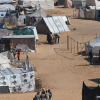In the wake of a 6.3 magnitude earthquake that struck western Afghanistan, claiming over 2,000 lives, the Taliban reported on Sunday that the nation is grappling with yet another crisis amid a deep economic downturn. The earthquake, centered 25 miles west of Herat city, marks the third-largest in Afghanistan. Taliban spokesman Zabihullah Mojahid stated that 2,053 people have lost their lives, with 1,240 individuals injured, and 1,320 houses either fully or partially destroyed. Rescue teams and essential supplies have been dispatched to the affected areas, but concerns persist that these figures may rise.
The earthquake's impact extended to neighboring provinces, accompanied by multiple aftershocks. Initial UN assessments suggested a lower death toll, but subsequent reports from the UN’s Office for the Coordination of Humanitarian Affairs (OCHA) revealed that nearly 500 houses were destroyed, affecting a total of 4,200 people (600 families). Images depict widespread devastation, with collapsed buildings and displaced communities seeking refuge in abandoned structures.
Afghanistan, already reeling from recent earthquakes and an ongoing economic and hunger crisis, faces additional challenges due to the aftermath of the Taliban's rise to power in 2021 following the US withdrawal. The withdrawal led to the freezing of approximately $7 billion of the country's foreign reserves by the US and its allies, coupled with the suspension of international funding, severely impacting an economy heavily reliant on aid.
In a recent warning, the World Bank highlighted that two-thirds of Afghan families currently face "significant challenges in maintaining their livelihoods." This economic strain exacerbates the difficulties for Afghans to recover from earthquakes, a recurrent phenomenon in a country prone to seismic activity.

















